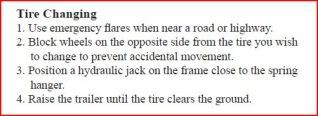RoadJunkie
Well-known member
There was a thread on the RV.net forum relating to alternate methods of raising a tire/wheel in order to exchange a flat tire for the spare tire. One opinion was to use a "bottle" jack and lift the 5th wheel unit, as described in the maintenance manual, at the frame. Another opinion described the use of a device--manufactured by Camco--named "Trailer-Aid", whereby this device is driven onto by the unflattened wheel which, in turn, raises the flattened wheel for exchange. Yet another opinion describes achieving the same results as the "Trailer-Aid" by using either commercial leveling blocks or wood planks, as required. Some owners feel that raising a wheel by alternate methods other than those described in the owner's manual may present unacceptable stress to the burdened tire and axle by shouldering the entire load of the unit during the tire exchange.
I would like to generate some discussion on this topic specifically related to Lippert frame characteristics and perhaps some insight based on discussions with Lippert that some of the forum users may have had.
I would like to generate some discussion on this topic specifically related to Lippert frame characteristics and perhaps some insight based on discussions with Lippert that some of the forum users may have had.


